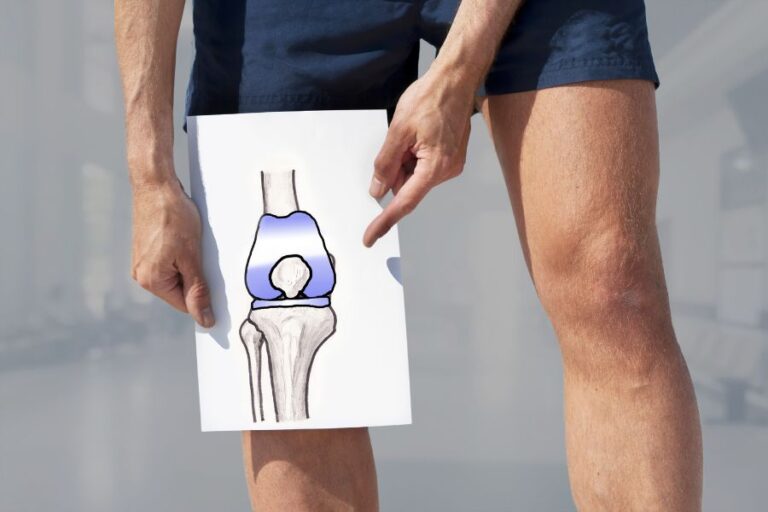- Phone: +91 94800 58379
- Mon-Sun 24/7
- contact.sanyrahospital@gmail.com


Knee Replacement

Knee replacement, also known as knee arthroplasty, is a highly effective surgical procedure designed to alleviate chronic knee pain and restore function in damaged knee joints. This surgery is ideal for individuals suffering from conditions such as advanced arthritis or osteoarthritis. During the procedure, the surgeon replaces the damaged joint surfaces with metal and plastic components, significantly improving knee motion and overall functionality. Knee Replacement in Bangalore provides patients with access to highly skilled surgeons and excellent medical facilities. Opting for this surgery can lead to a smoother recovery and long-lasting relief, enhancing the quality of life for those affected by severe knee problems. Whether it’s a partial or total knee replacement, the advanced techniques used ensure optimal outcomes and help patients return to their daily activities with ease.
The procedure for knee replacement, also known as knee arthroplasty,
It is a surgical intervention performed by an orthopedic surgeon.
Before knee replacement surgery, a thorough evaluation is conducted to determine the appropriate course of action for the patient’s specific condition. This evaluation includes a review of medical history, physical examination, and imaging tests.
Anesthesia is administered to ensure comfort and pain-freeness during the procedure, with options including general or regional anesthesia.
The surgeon makes an incision over the knee joint, either vertical or horizontal, depending on the surgeon’s preference and the specific knee condition. The damaged portions of the femur and tibia bones are carefully reshaped using specialized surgical instruments to create a smooth, stable surface for the artificial joint components. The artificial joint components, made of metal and plastic, are inserted into the prepared areas, with the metal component replacing the damaged end of the bone and the plastic spacer acting as the new joint surface between the metal components.
Patellar resurfacing is optional, and the back surface of the patella may be resurfaced with a plastic component to improve the knee’s movement and functioning. Balancing and testing are crucial for achieving optimal joint stability and function. After the components are securely in place and the knee’s functionality is confirmed, the surgeon closes the incision using sutures or staples, and sterile dressings are applied over the wound.
Post-surgery recovery is followed closely, with pain management, antibiotics, and other medications administered as prescribed. Most patients spend a few days in the hospital, beginning physical therapy to restore knee mobility, strengthen surrounding muscles, and improve walking ability. After hospital discharge, patients continue physical therapy on an outpatient basis, with healthcare teams providing instructions for wound care, pain management, and rehabilitation exercises.
Knee replacement surgery is a major procedure, and individual recovery experiences can vary. It is essential to follow the surgeon’s advice, attend follow-up appointments, and participate in rehabilitation for the best possible outcomes.
Post-surgery recovery and rehabilitation are crucial aspects of knee replacement surgery, with the success of the procedure and long-term outcomes relying on patients’ compliance with the rehabilitation program. The recovery process includes hospital stay, pain management, physical therapy, walking and weight-bearing, rehabilitation exercises, swelling and ice management, gradual resumption of activities, follow-up appointments, patience, time management, long-term management, and long-term care.
Hospital stay involves managing pain, administering antibiotics, and closely monitoring progress. Pain medications are provided to keep patients comfortable during the initial days, and as the recovery progresses, dosages may be adjusted. Physical therapy, which focuses on improving knee strength, range of motion, and flexibility, begins within a day or two after surgery.
Walking and weight-bearing gradually progress to using a cane and eventually walking without assistance. Rehabilitation exercises include quadriceps strengthening, hamstring strengthening, calf exercises, range-of-motion exercises, and balancing exercises. Swelling and ice can be managed by elevating the leg and using ice packs on the knee. Gradual resumption of activities, such as climbing stairs, driving, and performing light household tasks, is allowed as the patient progresses through the rehabilitation program.
Following-up appointments are scheduled to monitor progress, assess wound healing, and ensure the knee replacement is functioning correctly. Patience and time management are essential during the recovery process, and patients should listen to their body and avoid excessive strain on the knee. Long-term management, maintaining an active lifestyle, and following surgeon’s advice are crucial for the long-term success of the knee replacement.
You may need surgery if:
Our experienced Orthopedic Specialist in Kengeri offer advanced treatment options to ensure top-quality care. If you’re in Kengeri or Bangalore, we are dedicated to helping you regain mobility and enhance your quality of life. With modern facilities and comprehensive care plans, we deliver optimal outcomes for knee health. Trust us for the Best Knee Replacement Surgery in Kengeri or Bangalore. Our Knee Replacement Surgery procedures are designed to provide lasting relief and improved functionality. Contact us today to explore your treatment options and take the first step towards a pain-free life.
Our highly skilled Orthopedic Specialist in Kengeri are here to provide you with the best care available. Whether you need a Knee Replacement Surgeon in Kengeri or Bangalore, we ensure advanced surgical techniques and personalized treatment plans to help you regain mobility and improve your quality of life. Trust us for the Best Knee Replacement Surgeon in Kengeri or Bangalore. Contact us today to schedule a consultation and take the first step towards a pain-free life.
Knee replacement surgery is a transformative solution for chronic knee pain and reduced mobility. Understanding the procedure, benefits, and recovery process helps patients make informed decisions, ultimately regaining an active, pain-free life. Consult a qualified healthcare professional to determine the best course of action for individual circumstances.
It is typically recommended for individuals with severe knee pain or disability caused by osteoarthritis, rheumatoid arthritis, or traumatic injury that does not respond to conservative treatments.
The surgery usually takes about 1 to 2 hours, but the total time at the hospital can be longer due to pre-operative preparation and post-operative recovery.
Full recovery can take 3 to 6 months, but most people can resume normal activities within a few weeks.
Knee implants can last 15 to 20 years or more, depending on the individual’s activity level and overall health.
Yes, physical therapy is crucial for regaining strength, flexibility, and range of motion in the knee.
We are happy to assist you! Fill the form we will contact you soon!

Sanyra Hospital is a leading Multi-Speciality Hospital in Kengeri Bangalore and diagnostic centre. With a commitment to providing high-quality healthcare services, it offers a wide range of medical specialties and advanced diagnostic facilities to meet the diverse healthcare needs of the community. We have dedicated urology center & dialysis center.
© 2023, Sanyra Hospital. All Rights Reserved.
WhatsApp us